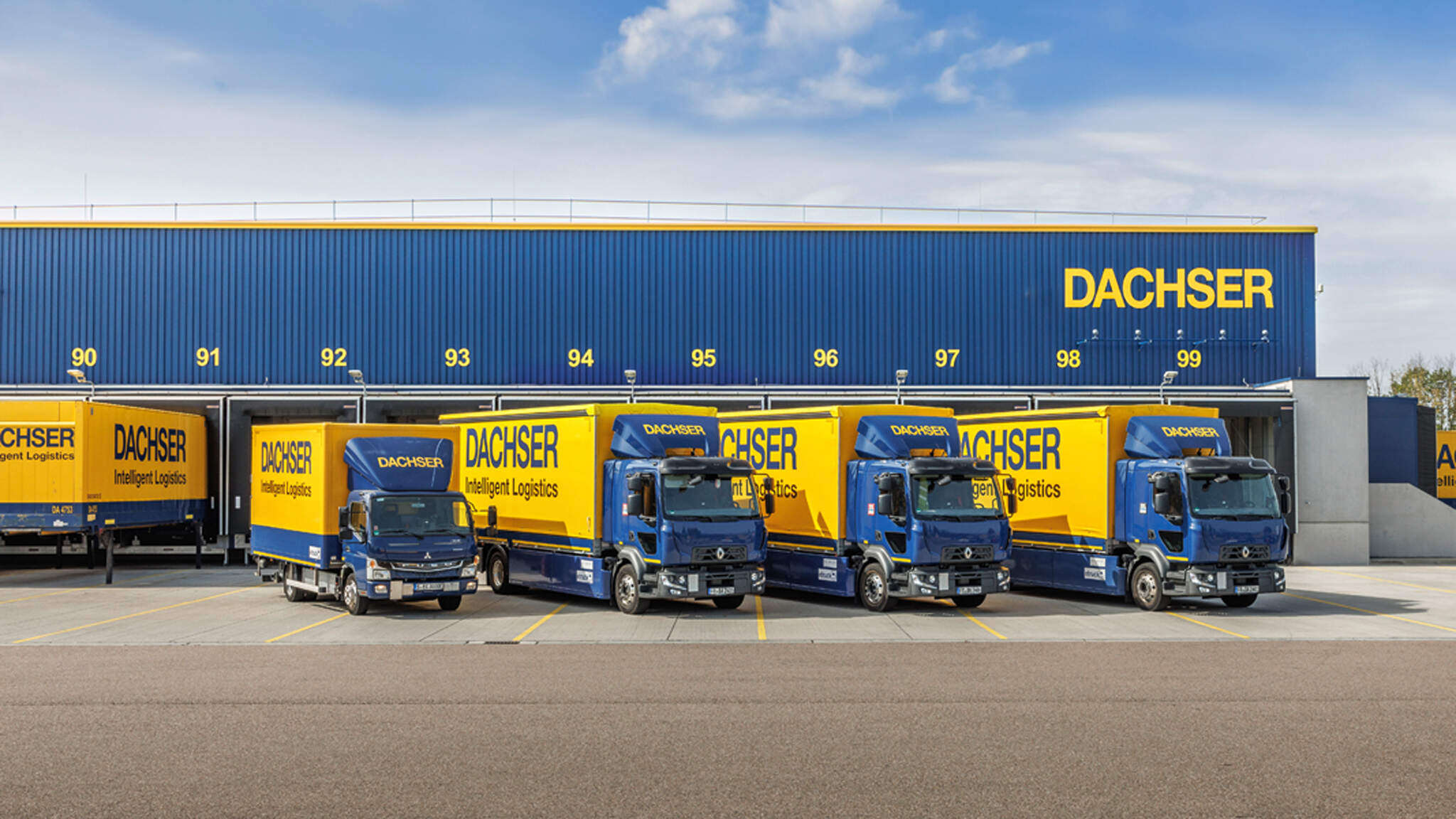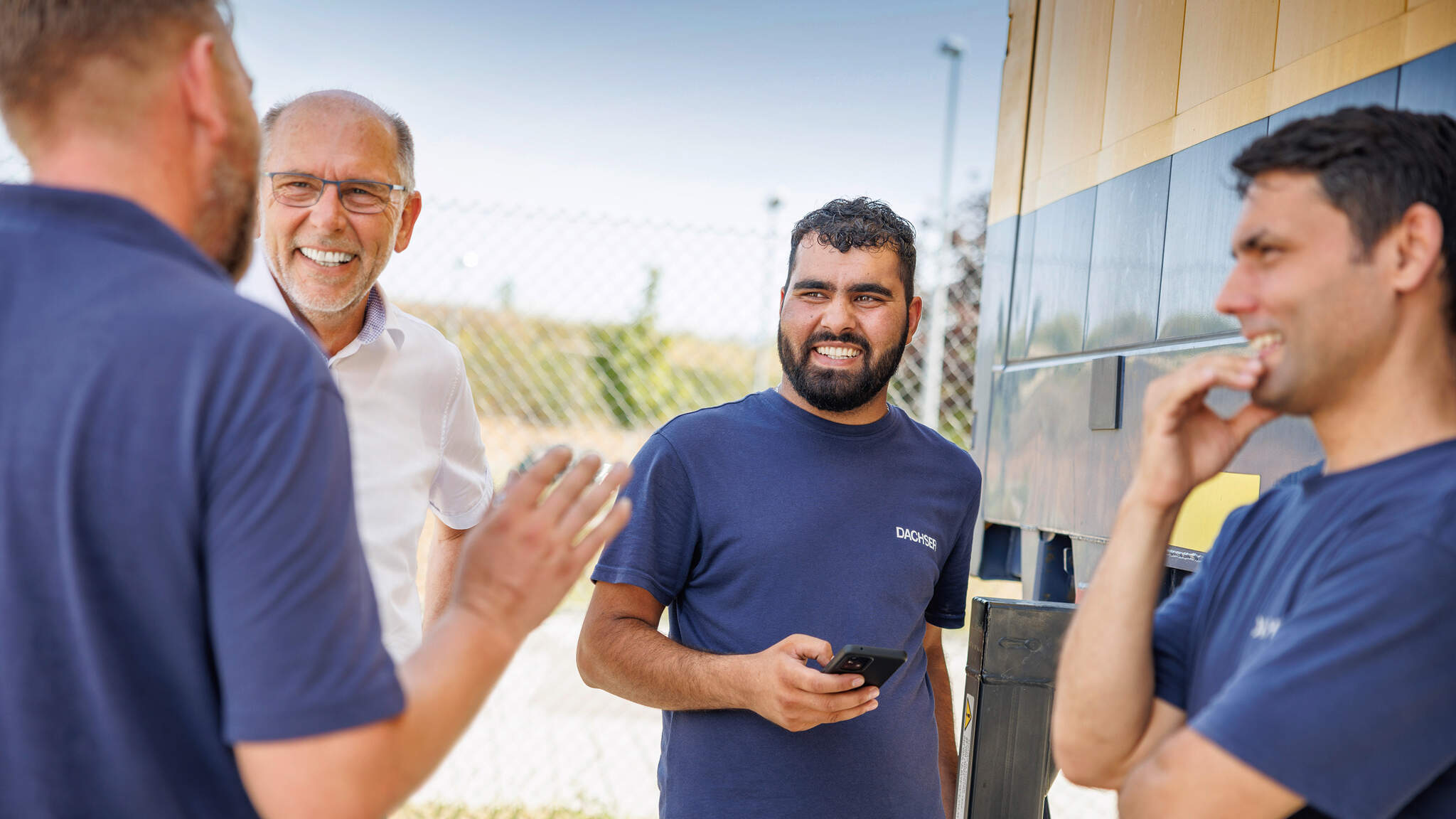Taking climate action together

Roc-Ket Cargo Bikes GmbH is a bicycle manufacturer specializing in transport logistics along the last downtown mile. It is headquartered on Neulindenstrasse near the former goods station, where it operates a microhub for parcel and groupage handling destined for Freiburg’s city center on behalf of customers such as DACHSER. Hendrik pedals his way, motor-assisted, to a bank office building just under two kilometers away, near the main train station. The bank is already expecting the shipment of marketing materials. Even though (or perhaps because) Freiburg is considered the bicycle capital of Germany, the cargo bike always attracts astonished looks from passers-by. “That’s really cool,” says a young man leaving the bank building for his break, as Hendrik rides by with his pallet.
In this way, DACHSER delivers a good 2 metric tons of goods a day to customers in downtown Freiburg. The cargo bikes, Hendrik’s included, are specifically designed for heavier loads. “We build our delivery bikes with tires, rims, spokes, and brakes like those used on mopeds. The motor has an output of 400 to 600 watts and can also go into reverse. That’s certainly a big help when you’re loading up to 250 kilos of cargo,” says Roc-Ket founder and Managing Director Thomas Ketterer. “Our pedelecs provide motor assistance only during pedaling and have a maximum speed of 25 kilometers per hour, even downhill.
Thanks to that, they’re allowed on bike paths, which means traffic congestion isn’t an issue for us in downtown deliveries.While Hendrik is delivering the 135-kilogram pallet of marketing materials, other DACHSER shipments have arrived at the microhub via a yellow and blue eCanter, the fully battery-electric 7.5-ton e-truck from Mercedes subsidiary FUSO. This truck provides a shuttle service from DACHSER’s Freiburg logistics center in the Breisgau industrial park, some 30 kilometers away, to ensure that the 150 m² downtown transit terminal is continuously supplied with new orders.
DACHSER has developed a way to deploy battery-electric trucks and vans in combination with electrically assisted cargo bikes and StreetScooters so that delivery in defined inner-city areas is completely emission-free. This concept is trademarked DACHSER Emission-Free Delivery and is now in regular operation in the Road Logistics business field—in 13 cities across Europe.
Ready for the mobility transition
And the challenges associated with active climate action are already very present in day-to-day logistics operations. “We expect urban road freight to shift to zero-emission trucks in the coming years. We’re already making important preparations at our DACHSER Emission-Free Delivery locations for this far-reaching transformation, which will improve the quality of life in congested downtown areas in particular,” explains Alexander Tonn, COO Road Logistics at DACHSER. “Zero-emission delivery in defined downtown areas is a key building block in advancing electromobility at DACHSER. It also plays a crucial role in optimally preparing the company and our customers for the bans on combustion vehicles that are planned or already in force in larger metropolitan areas.”
Today, DACHSER provides emission-free delivery of non-refrigerated groupage shipments in defined downtown areas in 13 European metropolitan regions: besides Freiburg, the major German cities of Berlin, Dortmund, Hamburg, Munich, and Stuttgart, plus Copenhagen, Madrid, Oslo, Paris, Porto, Prague, and Strasbourg. Eleven more major European cities are to follow by 2025.
Michael Gaudlitz, General Manager of DACHSER’s Freiburg logistics center, is all fired up with enthusiasm for the project. He and his team are among the pioneers of e-mobility in the DACHSER network. “We started here back in 2017, together with Roc-Ket, making deliveries to the city center including with electric cargo bikes. In 2019, DACHSER added an eCanter, a prototype for an electric 7.5-ton truck with a range of around 100 kilometers. Since then, we’ve kept on expanding our electric fleet.” For example, the eCanter in the Freiburg branch’s fleet has recently received “reinforcements” in the form of three 16-ton e-trucks from Renault.
One of the drivers is Rafiullah Faqiri, a 23-year-old professional DACHSER driver whom everyone just calls Rafi. He has been driving electric vehicles for DACHSER since his apprenticeship. “Electric driving is very different from driving diesel trucks: much quieter, much more relaxed, and yet much more dynamic,” Rafi says. “And wherever we take these vehicles, we’re greeted by beaming faces and immense enthusiasm for e-truck delivery.”

E-mobility that’s fun
Freiburg deliberately uses the allure of e-mobility to make the career of professional driver more attractive: “Right from the start, we aim to introduce our apprentices to new technology and thus to the future of urban logistics,” says Rolf Hügel, Operations Manager Inbound at DACHSER’s Freiburg logistics center. “Our drivers should enjoy their work—and also be able to take a little pride in knowing their efforts are helping to secure a bright future.”Rafi reports that e-truck driving is also a skill to be learned. For him this includes things like planning routes with dispatch and fleet management so that battery charging can always take place at the DACHSER branch. “Finding a fast-charging station somewhere on the road is next to impossible,” says the young professional driver. “But I’ve never been stranded. At some point, you just know the vehicle’s capabilities and limitations inside and out.”
Even so, there’s no shortage of challenges when it comes to incorporating e-mobility into everyday logistics. “Launching new technologies always results in some teething problems. For example, we’ve had to tackle anticipatory, energy-efficient driving, correct battery charging, and the development of a suitable, high-performance charging infrastructure. Everyone involved had to go through a learning process,” Gaudlitz recalls.
Benefit from experience
The eCanter in Freiburg’s fleet is a perfect example of learning on the job. Hügel recounts how in 2019, when DACHSER began operating this vehicle, the company’s service partners had little or no experience with the maintenance and repair of electric trucks. The DACHSER achser workshops also lacked the high-voltage technicians who would have been qualified to work on it. “Initially, we had to fly in a service team from Japan specifically for repairs to the eCanter, and so the work dragged on for a correspondingly long time. That was part of the learning curve for everyone involved,” Hügel says. “In the meantime, we’ve significantly expanded our workshop network, we’ve gotten repairs and maintenance cycles under control, and we’re benefiting from the large amount of experience already gained as we expand the energy supply and charging infrastructure.”

Ready for the next step
“As an e-mobility site in the DACHSER network, we now want to take the next step toward climate action here in Freiburg,” says General Manager Gaudlitz. “This means significantly increasing our electric fleet and adapting the infrastructure accordingly.” In addition to the eCanter and the three Renault 16-ton trucks, the fleet will be expanded at the beginning of 2024 to include two distribution vehicles, a swap-body lift-truck, and three 40-ton truck tractors. DACHSER will add a further two large truck tractors, three swap-body carriers, and another electric swap-body lift-truck in 2025.“To operate a fleet of 16 e-trucks in total, we need a corresponding amount of electricity,” Gaudlitz says. “That’s why here in Freiburg, we’re investing in five more fast-charging stations, ten wall chargers for the branch’s trucks, and an additional transformer substation. We’re also installing a photovoltaic system on the terminal building, and procuring power storage batteries to cover peak loads when demand for electricity and charging is high.”
However, Gaudlitz points out that the branch wouldn’t be able to handle such an undertaking on its own: “The expansion of zero-emission delivery is a task that must be shared across a strong network. To this end, we’re in close contact with other branches and the specialists from the Head Office in Kempten.” DACHSER is supporting the branch’s investments with funds from the Climate Protection project budget, but also with plenty of network knowledge. For example, members of the Freiburg team recently sat down with the construction department in Kempten to discuss all the technical and building challenges involved in the upcoming expansion of the charging infrastructure. “We’re not focused just on advancing our own branch; it’s much more about achieving quality for the network,” Gaudlitz emphasizes. “That’s why we regularly share our knowledge and all our experience with the project managers at DACHSER headquarters and with other DACHSER branches. This way, everyone’s a winner.”
Meanwhile, in Freiburg’s city center, Hendrik has arrived back at the microhub on Neulindenstrasse after completing his route with the Bigster, and Rafi has just unloaded a new delivery for his colleagues and their cargo bikes. While the freight data transfer is running, there’s a few minutes for the DACHSER drivers to chat. “Work should be fun,” Rafi says, adding playfully: “That’s just a plug for our electric vehicles.” Shortly after, both are back on the road again.